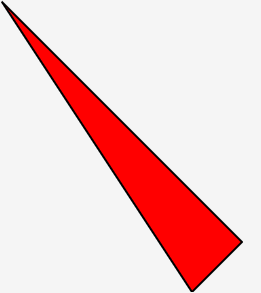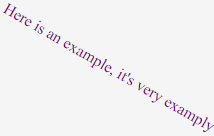HTML SVG
在 HTML 中使用图像对于多媒体丰富的网站来说非常棒。您所要做的就是在 HTML 代码中添加一个标签,然后 viola,您的浏览器就会显示您选择的图像,甚至添加一个链接。当您知道图像或图表将被放大时,这会有点麻烦,因为 JPG 或 PNG 一旦放大到超过其分辨率,就不会显示任何进一步的细节。 SVG 就是这个问题的解决方案。 SVG 代表可缩放矢量图形。顾名思义,这些可以根据需要放大,并且细节永远不会消失。 SVG 并不是 Web 技术所独有的,但在 HTML 中使用它们确实很巧妙。 SVG 对于浏览器中的图表、矢量图、图表和图形很有用。
在 HTML 中嵌入 SVG 的语法:
与在 HTML5 中使用 canvas 类似,有一个简单的标签可用于在 HTML5 页面中嵌入 SVG。
语法:
<svg width="width here" height="height here "> …. …. …. …. </svg>
HTML 中的 SVG 示例
下面给出了一些可以在 HTML5 中创建和嵌入的矢量示例:
示例 #1 – 在 HTML 中通过 SVG 绘制矩形
代码:
<!DOCTYPE html> <html> <body> <svg width="500" height="600"> <rect width="400" height="200" style="fill:rgb(0,0,200);stroke-width:5;stroke:rgb(255,0,0)"/> Sorry but this browser does not support inline SVG. </svg> </body> </html>
输出:

示例 #2 – 在 SVG 中绘制带圆角的正方形
对于带有圆角的正方形,除了正方形的大小和尺寸外,我们还必须使用 rx、ry 来定义角的半径。
代码:
<!DOCTYPE html> <html> <body> <svg width="500" height="500"> <rect x="100" y="100" rx="30" ry="30" width="300" height="300" style= "fill:green stroke:blue; stroke-width:5 ; opacity:0.5" /> Sorry but this browser does not support inline SVG. </svg> </body> </html>
输出:

示例 #3 – 在 SVG 中绘制一个圆圈,其中包含轮廓和颜色填充
代码:
<!DOCTYPE html> <html> <body> <svg width= "400" height= "400"> <circle cx= "100" cy= "100" r="90" stroke= "red" stroke-width="1" fill="grey" /> Sorry but this browser does not support inline SVG. </svg> </body> </html>
输出:

示例 #4 – 在 HTML5 中使用 SVG 绘制直线
我们可以使用
代码:
<html> <body> <svg width= "400" height= "400"> <line x1 = "5" y1 = "5" x2 = "300" y2 = "300" style = "stroke:yellow; stroke-width:3"/> </svg> </body> </html>
输出:

示例 #5 – 在 HTML5 中通过 SVG 绘制日食
我们可以使用
代码:
<!DOCTYPE html> <html> <body> <svg height="300" width="300"> <ellipse cx="150" cy="100" rx="120" ry="70" style="fill:brown; stroke:green; stroke-width:3" /> Sorry but this browser does not support inline SVG.</svg> </body> </html>
输出:

示例 #6 – 在 HTML5 中使用 SVG 创建多边形
标签可在 SVG 中用于创建多边形。在标签中,我们需要提及每个点的位置。填充颜色、轮廓粗细等,也可以在代码中定义。
代码:
<!DOCTYPE html> <html> <body> <svg height="300" width="600" > <polygon points="10,10 250,250 200,300" style="fill: red; stroke: black; stroke-width: 2" /> Sorry but this browser does not support inline SVG. </svg> </body> </html>
输出:

示例 #7 – 在 HTML5 中使用 SVG 创建折线
折线用于绘制仅由直线组成的形状。请记住,这些线也必须连接。这是 HTML5 中折线实现的示例。
代码:
<!DOCTYPE html> <html> <body> <svg height="300" width="600"> <polyline points="10,10 60,60 70,100 80,120 300,200 250,300" style="fill: none; stroke: black; stroke-width: 3" /> Sorry but this browser does not support inline SVG. </svg> </body> </html>
输出:

示例 #8 – 在 HTML5 中使用 SVG 绘制文本
在许多情况下,文本对于任何 SVG 都是必需的,例如标记图表等。幸运的是,存在一个
代码:
<!DOCTYPE html> <html> <body> <svg height="300" width="500"> <text x="10" y="20" fill="purple" transform="rotate(30 20,40)">Here is an example, it's very examply </text> Sorry but this browser does not support inline SVG. </svg> </body> </html>
输出:

示例 #9 – 在 HTML5 中使用 SVG 绘制星星
现在我们已经完成了基础知识,让我们创建一个借助 SVG 制作的星星。
代码:
<!DOCTYPE html> <html> <body> <svg width="400" height="400"> <polygon points="110,10 50,198 200,78 30,78 170,198" style="fill:orange; stroke:green; stroke-width:5; fill-rule:evenodd;" /> Sorry but this browser does not support inline SVG. </svg> </body> </html>
输出:

示例 #10 – 在 SVG 中使用线性渐变
您可以在 SVG 多行 HTML Canvas 中使用线性和径向渐变。渐变必须嵌套在
代码:
<!DOCTYPE html> <html> <body> <svg height="300" width="400"> <defs> <linearGradient id="gr1" x1="0%" y1="60%" x2="100%" y2="0%"> <stop offset="5%" style="stop-color:rgb(255,255,3);stop-opacity:1" /> <stop offset="100%" style="stop-color:rgb(255,0,0);stop-opacity:1" /> </linearGradient> </defs> <ellipse cx="125" cy="150" rx="100" ry="60" fill="url(#gr1)" /> Sorry but this browser does not support inline SVG. </svg> </body> </html>
输出:

结论
对于需要使用图表的网站,SVG 是一个救星。大多数现代 Web 浏览器除了可扩展之外还支持 SVG。使用 SVG 的另一个好处是它的文件大小。因为它只是一点代码,所以与传统图像相比,SVG 占用的内存和带宽非常小。
以上是HTML SVG的详细内容。更多信息请关注PHP中文网其他相关文章!

热AI工具

Undresser.AI Undress
人工智能驱动的应用程序,用于创建逼真的裸体照片

AI Clothes Remover
用于从照片中去除衣服的在线人工智能工具。

Undress AI Tool
免费脱衣服图片

Clothoff.io
AI脱衣机

Video Face Swap
使用我们完全免费的人工智能换脸工具轻松在任何视频中换脸!

热门文章

热工具

记事本++7.3.1
好用且免费的代码编辑器

SublimeText3汉化版
中文版,非常好用

禅工作室 13.0.1
功能强大的PHP集成开发环境

Dreamweaver CS6
视觉化网页开发工具

SublimeText3 Mac版
神级代码编辑软件(SublimeText3)














